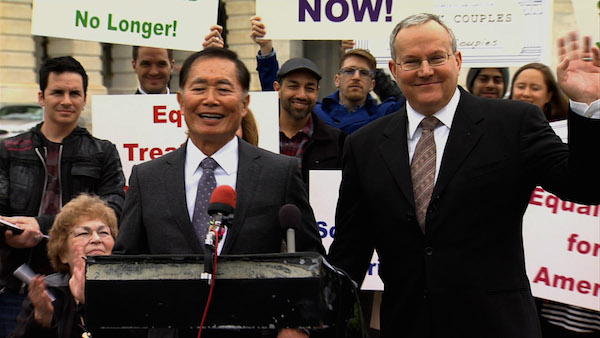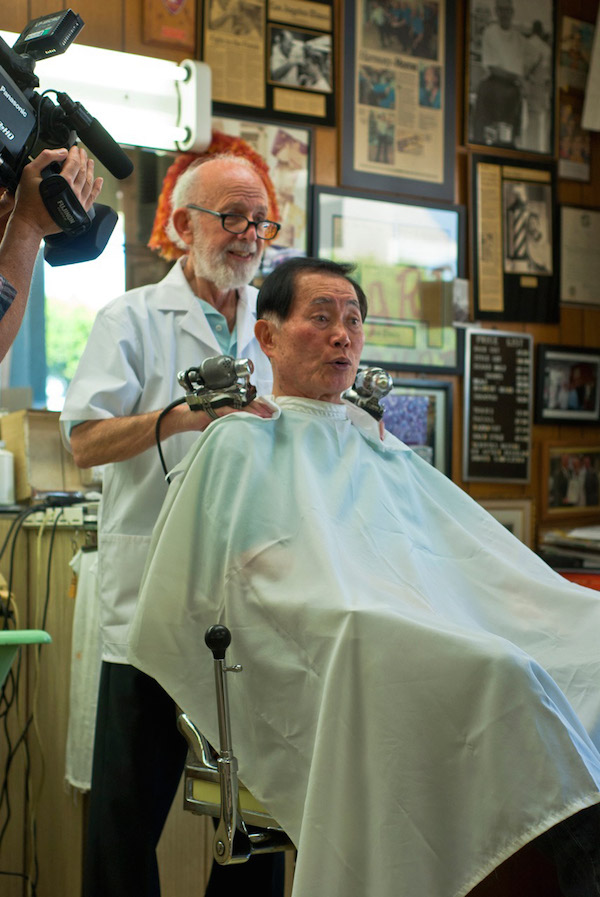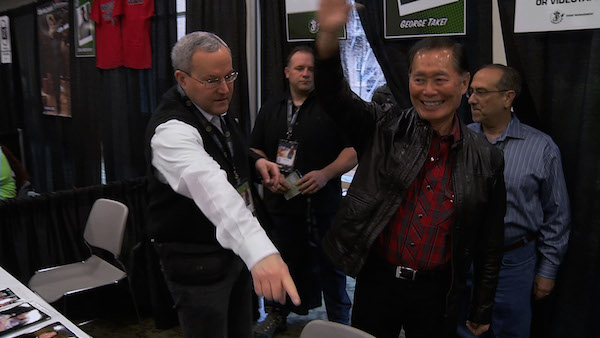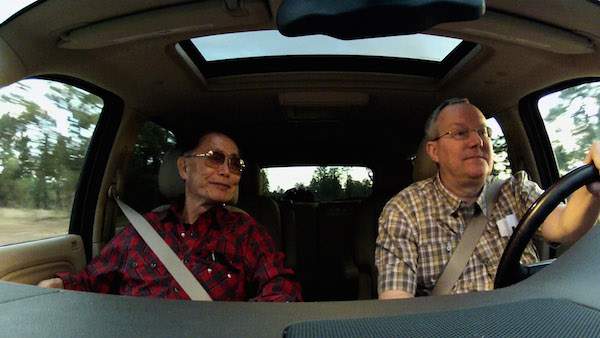George Takei (rhymes with: here to “stay”) is a formidable presence. He has journeyed from the Japanese-American internment camps of his childhood, to television screens throughout the galaxy aboard the Enterprise (as Mr. Sulu of the original Star Trek crew), to political lecterns and halls of justice advocating for civil rights at home and overseas. George Takei’s life has been transformed, as he acknowledges, “almost as fantastically as science fiction.” To Be Takei, the documentary film directed by Jennifer M. Kroot and co-directed and edited by Bill Weber, tells a rich and relevant story of a true American hero. To Be Takei is as elucidating as it is entertaining, as it is moving.
While most of us know of that shameful chapter in our country’s history, the establishment of Japanese-American internment camps subsequent to the bombing of Pearl Harbor, Takei’s description of the hardships that he and his parents “endured with dignity” (“gaman,” in Japanese), gives voice to specifics of the injustices perpetrated right here within the borders of our so-called “democracy.” Takei draws many parallels between the discrimination he faced as a Japanese American child and as a homosexual adult. It was not until 2005, at the age of sixty-eight, when prompted by Governor Schwarzenegger’s veto of The Marriage Rights Bill in California, that Takei was prompted to emerge full-force from the closet to become an eloquent and impassioned spokesperson on behalf of marriage equality and LGBT civil rights.
Today, at the age of seventy-seven, George Takei is happily married to his partner of twenty-nine years, Brad, and he is more active and celebrated than ever. Whether appearing as Howard Stern’s official announcer, writing and producing a new Broadway musical, or hosting an online technology show for seniors, Takei observes, “I am the beneficiary of an optimistic view of life.”
Per George Takei’s poignant example, may we all be so blessed to “live long and prosper.”
I enjoyed speaking with director Jennifer M. Kroot and co-director and editor Bill Weber about their documentary film, To Be Takei, their collaboration, and about the heroes at the heart of it all, George and Brad Takei.
Sophia: Based on reading George Takei’s autobiography, To The Stars (1994), you became interested in making this documentary. What in particular about his story captured your imagination?
Jennifer M. Kroot: It was the combination of my interest in Star Trek and really admiring George for coming out and becoming an LGBT civil rights activist at age sixty-eight. He didn’t have to do that; he didn’t have to get so involved. I found his honesty and his ability to laugh at himself around that issue charming and endearing. The autobiography focuses on his experience of being imprisoned in Japanese-American internment camps. I found it unbelievable that he had endured so much. That the United States government had imprisoned Mr. Sulu was just so strange?! He really was the first friendly Asian face on T.V. in Hollywood. How did he connect the dots from that beginning to becoming part of the biggest pop culture phenomenon ever?
Sophia: As George Takei describes: “My life has been transformed almost as fantastically as science fiction.” You have remarked, “He’s Barack Obama meets Mr. Rogers meets John Waters.”
Jennifer: That makes perfect sense, doesn’t it? He has elements of all those [personalities]. He is very professorial, just as Barak Obama is always accused of being. Like John Waters, George has this outrageous gay-man character [he lets loose] on Howard Stern. And he’s got a little Mr. Rogers in him. He is this gentle soul, who is supportive, who wants to give advice and offer solutions to people. So I see all of those [personas] in George … and he has a bit of the Dalai Lama in him.
Sophia: You have called George Takei “the Dalai Lama of pop culture” —
Jennifer: There is a lot of meaning that his fans derive from George. Whether they listen to him speaking out about race or LGBT civil rights issues in the media, when they see him at Comic-Con or meet him on the street, they get a special moment with this person who has faced obstacles and talks about overcoming them. So they want to share with him what’s going on with them as well, and he really listens to them in that moment. It is very powerful.
Bill Weber: The Dalai Lama always says his own religion is “kindness.” George is a very kind person. Like the Dalai Lama, George is very inclusive and compassionate.

Sophia: I was really struck in the documentary when George comments that his life is better at 71 years of age than it has ever been. There are very few people who can make that claim about aging.
Jennifer: I really admire older people that can keep living their lives and remain positive. I made a documentary about George Kuchar (It Came from Kuchar, 2009), and Kuchar was also an artist doing amazing things as he aged. Kuchar was still obsessed with creating. I think George Takei in that same way continues to be very engaged in his life. Because he had been imprisoned as a child, he doesn’t take anything for granted — also, because his career has not always been as huge as it is now. He’s out there. He wants to make the country a better place by going out and talking about democracy and civil rights.
Sophia: Jennifer, was there a film of Bill Weber’s that brought you to the realization, “I want to work with Bill on this project.”
Jennifer: I loved The Cockettes (2002). Then I really loved We Were Here (2011). I think those two films are very different than To Be Takei, but I could see that Bill had such a broad range and really had compassion for the characters. My greatest fear as a documentary filmmaker: I never want to make a train wreck. There’s no reason to make fun of characters. George Takei is often a punch line on Facebook, but I want to see that humanity within that. Bill is really into finding the humanity within people.
Bill: I think documentaries should be love stories. The Galapagos Affair, that was a big love story. I fell in love with those characters big time. All of them. And the Takeis too, I fell in love with them.
Jennifer: I know.
Sophia: Bill, what was your inroads to filmmaking?
Bill: For years, I’ve edited T.V. commercials and music videos, and then about sixteen years ago, a mid-life correction happened. The Cockettes, this drag theatre company in San Francisco around 1970, were very important to me. I was a young gay kid in Kansas, and the gay images out at the time were very scary, conservative, and sort of pathetic. When The Cockettes came around, it was all of a sudden this opportunity to see gay people as crazy hippies doing political theatre on drugs. That was a big eye-opener for me. A friend suggested, “Let’s do a documentary on The Cockettes, and I was like, “Yes!” It was mainly a thank-you to those people for enlightening me when I was a teenager. That’s when I discovered that I loved documentaries, and I have been doing them ever since.
Sophia: Bill, you are both the co-director and the editor on this project. To Be Takei is quite a feat of editing. There are so many thematic strands. How did you and Jennifer work together to assemble this puzzle?
Bill: Jennifer came to me, and I asked, “What are the themes?” “Well, here are some of them,” she said, as she handed me a list of about eighteen.
[Big laugh.]
Jennifer: And he went, “I’m out of here. See you later.” I sought out Bill as the best editor around. I knew this was an intricate puzzle, and I needed someone smart, capable, and fearless to help put it together. Someone who also had compassion for the characters and really understood where I was coming from with all these different themes. I think I saw Bill fall in love with the Takeis (George and Brad), as we made the film, which was great and also a relief to me.
Bill: I think we spent the first three or four months just putting all the different stories together. There were a lot of stories! Then it was like, how do we weave them together? We got a couple of great big boards and a whole lot of note cards, and we just sort of kept re-shuffling things, finding what worked, and what didn’t. That’s one thing I like about editing documentaries: if you really listen, the material will tell you how to put it together at some point.

Sophia: What did this material tell you to do?
Bill: There’s the character of George, there is this loving functional-dysfunctional relationship, there is the quest to make the world a better place, and there’s the sense of fun that hopefully gets woven in and out of the film. We can become very involved in the world, we can be in relationship, and we can have a good time with it all.
Sophia: Part of the fun of the film is the antagonism you capture between Shatner and Takei —
Jennifer: [with an edge of sarcasm] Yeah, that is fun. Everybody loves that. I like it.
Sophia: It’s got a dark edge –
Bill: I think they even like it.
Sophia: That clip where Takei confronts Shatner, where did you find it?
Jennifer: That’s the Comedy Central “Roast of William Shatner.” Early on, I saw it on the internet. I would look online and find George, very professorial, giving a civil rights speech, but then I would see him on comedy central saying, “Fuck you!” to William Shatner.
Bill: Shatner has been such a great, larger-than-life character, too for the past fifty years, and he continues to be.
Jennifer: I really appreciate his willingness to do an interview for the documentary and to be such a good sport about it.
Sophia: Where did you get the idea to include the fanzine slash comics homoerotic imagery of Shatner and Nimoy together? It is so funny, that contrast between Shatner’s discomfort and that imagery. That’s just brilliant.
Jennifer: I guess that was my idea. I have to say, it’s something I became obsessed with early on. When I was researching George, I got on some web tangent into this slash art. I always thought, it is so interesting how Star Trek still up until this day has never included an LGBT character. It is a show that has a history of being very forward thinking on civil rights, very politically progressive, so this omission is a little disappointing. That fans would find a way to make some of the characters homosexual, in any case, is so inventive.
That certainly could be Spock and Kirk. I mean, we don’t actually know if it’s a bromance or a romance, but Kirk and Spock certainly had a very tight bond. I admire people coming up with creative solutions and making the characters into who they need them to be.
Bill: Eroticizing the characters.
Jennifer: I think it’s great. I thought, if I get to talk to these Star Trek characters, I have to ask them what they think of this artwork. So I made sure to ask everybody.
Sophia: How did you decide who to interview?
Jennifer: I wanted to interview all of George’s Star Trek colleagues that are still around and John Cho, the new Sulu. It was so important to interview Howard Stern because George recognizes that Howard reignited his career, pretty much single-handedly. I wanted to interview some of George’s Japanese-American politician friends with whom he is working on the redress movement. I wanted to interview columnist Dan Savage because of his voice on LGBT sexuality in the media and what it means when a celebrity comes out. I wanted to include George’s sister. Initially, she was very shy and didn’t want to be interviewed, but she came around.
Sophia: Since 2006, George has been the official announcer of the Howard Stern show. What does that entail?
Jennifer: George almost outed himself, accidentally, the very first time he was a guest on Howard’s show. At the time, of course, George immediately denied that he was gay. After that, Howard was pranking George for years. I think Howard kind of fell in love with the humor around George’s very sincere delivery and gullibility. Then, once George officially came out, Howard’s people and Howard decided they wanted to ask him to be the official announcer of the show full-time. George lives mostly in Los Angeles. He didn’t want to live full-time in New York; so instead he offered to do the job part-time, three or four times a year, for a week at a time. George apparently gets more fan letters than anyone else on Howard’s show — despite the fact that he is not full-time. His participation on Howard’s show has really broadened George’s appeal. Sometimes it’s outrageous what George is talking about, but he’s changing the hearts and minds of people who maybe wouldn’t typically be interested in marriage equality or civil rights for LGBT people.
Bill: George has a fearlessness about him that really comes across on the Howard Stern show. George will talk about anything. He’s very open, very approachable. I think Howard really appreciates that. When we were at Sundance, gay marriage had been legal in Utah for a very brief time, and the governor had just voided all the gay marriages that had taken place in the state. George would go up on stage after the screenings, and the first thing out of his mouth was: “Your Governor is on the wrong side of history here.” Right off the bat, he just gets into it; it’s a beautiful thing about George. That’s one of the reasons, I think, why he is so successful on the Howard Stern show.
Jennifer: He doesn’t take himself too seriously. He can laugh at himself. He just says what he thinks. He has nothing to lose.
Sophia: How did you get George Takei to agree to participate in the making of this documentary about his life? You didn’t know him. What was your approach? How long did it take you to convince him to agree to the project?
Jennifer: I wrote a compelling letter to his agent. His agent apparently had enjoyed my previous documentary, It Came from Kuchar. A week after I sent the email, he called me and offered to set up a meeting between me and George and Brad. So I was pretty surprised. So then, I met them. I think personality-wise, we pretty much clicked right away. But, you know, it’s a complicated thing to do. So we had a series of meetings over several months before we started filming. George was pretty much like [in her Takei voice]: “Oh, wonderful! We just loved your film.” [Big laugh.] And then Brad was like, “How long is this going to take? How much footage do you need? When are we going to start? Are you going to move here? What are we going to do? …” All these questions — that’s Brad.
Sophia: The nuts and bolts guy.
Jennifer: That’s why George doesn’t have to worry about anything. He’s got this guy. Lucky for him, his husband is willing to do all of this looking out for him: making sure I’m not a nut or a potential stalker, making sure that it’s all going to make sense for them. I probably wouldn’t ever commit to something like that myself, so I’m glad that Brad did ask all those questions, and they chose to do it.

Sophia: So did you end up moving to Los Angeles to make the documentary?
Jennifer: Hell, no. You don’t need to do that! Brad doesn’t know; he hasn’t done this before. I just visited them there from time to time. A lot of times, they’re not even there in Los Angeles. I followed them all over the country.
Bill: Jennifer filmed them in Seattle, Portland, Arkansas, Arizona, Los Angeles, New York–
Jennifer: And San Francisco.
Sophia: Were George and Brad involved at all in the editing process?
Jennifer: They gave us complete editorial control. They saw the finished film for the first time at Sundance. The both really enjoyed it. I think Brad was really moved; he felt appreciated as George’s husband in the film. They talk about both of their mothers passing away, and I think that part of the film is especially meaningful to both George and Brad.
Sophia: Brad was the primary caretaker for George’s mother when she was incapacitated by Alzheimer’s disease towards the end of her life. George expresses how indebted he feels to his husband Brad for his tender and loving care of her.
Bill: My husband’s mother came to the opening of the film in San Francisco, and she ran up to Brad afterwards and in front of me asked, “Is it really important for gay son-in-laws to take their mom-in-laws in when they need help?” [Big laugh.]
Sophia: When you started making the film, George Takei did not have a social media presence, but now he has over 7 million followers worldwide on Facebook, Twitter, and Google+?
Jennifer: He is Facebook! [Huge laugh.] He was voted “Most Important Presence on Facebook,” by Wired Magazine, a couple of times. While he does have a very large following — it’s up to 7.3 million now — he doesn’t have the largest following. What he does have is the largest amount of people who are reposting. So even if you are not George Takei’s friend or fan, they keep reposting what he says. He has this huge circulation way beyond that 7.3 million, which is already a pretty staggering number. I saw it just take off, and I was like, that’s crazy!
Sophia: Apparently, George went on social media sites because he wanted to promote the musical that he helped to develop, Allegiance, which is based on his true life experiences in the internment camps. The musical previewed at the Old Globe theatre in San Diego in 2013, and he and his team are planning to mount the show on Broadway. Watching your film made me very excited to see the musical. Do you know the current status of that project?
Jennifer: It’s in limbo, hovering over Broadway. I think they are positioning themselves to book the right-sized theatre. The producers are outsiders to Broadway, but they’re going to do it because they’re really relentless in their desire. The show did so well in San Diego. In the next one to two years, I would imagine that they will succeed in achieving this dream.

Sophia: George Takei was appointed by Bill Clinton to serve on the US Japan Friendship Commission, and in 2004, he was invited to travel to the Emperor’s palace in Japan to accept an award for his service (Order of the Rising Sun, Gold Rays with Rosette). George traveled to Tokyo with Brad (his partner at the time, today they are married). When they arrived by bus at the palace, they were told that only married couples were permitted inside. Brad was asked to remain on the bus, and George went inside the palace alone to receive the award. George did not stand up for his partner at that time. Did you ever ask George if he harbored shame or regret about that choice? Did you sense any bitterness from Brad that George didn’t come to his defense in that instance?
Jennifer: That’s an interesting question. A lot of gay couples have asked me why George made that choice. George explains that they had made the journey to Tokyo, and it was something unexpected that happened suddenly. I think he felt bad about the whole thing. I don’t know exactly what Brad would say about it.
Sophia: Brad may have encouraged him, selflessly, “Please, go.”
Jennifer: Yeah, what do you do? It was really an unfair situation because the officials saw them get on the bus together. It’s this incredible honor, but obviously, at that time, the homophobia was too great. Interestingly enough, on a recent trip to Japan, George and Brad met the first lady of Japan, the Prime Minister’s wife, and she told them that she had just participated in a gay pride parade and had a great time. They felt really good about that.
Sophia: So things are changing in Japan, too.
Bill: I think George really respects cultural institutions. I think that he will push things when the time is right. I think he’s really smart that way. He will push it, but I don’t think that would have been something he would have pushed at that time.
Jennifer: It was the same with the internment. We know that that was wrong, but if you had tried to protest it at the time, you might have been taken to jail or shot. So you wait until the time is fertile for redress and reparations.
Sophia: That’s a great point. I just spoke with Ira Sachs about his new film, Love Is Strange. In the film, Alfred Molina’s character loses his job as a music teacher at a Catholic school as a result of his same-sex nuptials. Sachs observed that these characters would not press charges in a civil rights case to fight such discrimination. Sachs said, “I would, but these characters wouldn’t.” It is the approach of a different generation.
Bill: George Takei does come from a different generation. I have to remind myself of that every so often.
Jennifer: He looks younger, but he’s seventy-seven now.
Sophia: We all hope to look so good. How did you come up with the title of the film?
Jennifer: Brad came up with it. It’s half of the slogan, “It’s OK to be Takei,” which they developed on account of the Tennessee law (which was enacted, by the way), making it illegal for teachers to use the word “gay” or “homosexual” in any public school classroom in Tennessee. I don’t know what the actual penalty is.
Sophia: That’s so different than San Francisco.
Jennifer: Where you have to reference homosexuality in the classroom!
Sophia: I was listening to a debate on the radio this morning. Parents are voicing distress with the San Jose school district about the new sex education textbook that district has purchased for use in high schools that includes chapters on bondage and fetishes.
[Enormous laugh.]
Jennifer: Well, good. And is there a “slash” chapter? “It’s OK to be Takei” (instead of “gay”) became a campaign. So that you could say it, without saying it. George’s fans are familiar with the campaign. The title also refers to “The Takeis” – George and Brad Takei, the couple at the heart of this story.
Bill: The title was inclusive of Brad —
Jennifer: So we liked it when we heard it.
Top Image: George Takei holding his Sulu “Star Trek” action figure, “To Be Takei.” Photo courtesy of Amplify.
“To Be Takei” Official Website
Link to George Takei “It’s OK to be Takei” Campaign Video Clip

